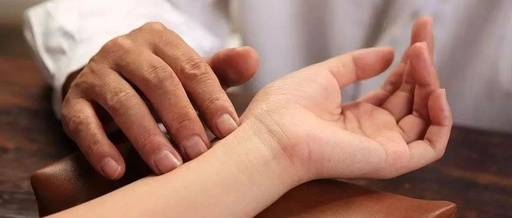From a professional standpoint
Explaining Traditional Chinese Medicine
This is the 601st original article by the author

With three fingers, one can discern life and death; by pressing the pulse at the wrist, one can know the ailments. Pulse diagnosis is a unique diagnostic method in Traditional Chinese Medicine (TCM) and is indeed remarkable. While it is fascinating, it is also difficult to learn and understand. Even practitioners of TCM often feel that while they may have a clear understanding in their hearts, it is hard to articulate through their fingers, making it seem mysterious to the general public.
However, this is not the case; pulse diagnosis in TCM has observable patterns that can be objectively assessed. Let us explore the pulse phenomenon known as the “slippery pulse” together.

Pulse diagnosis involves feeling the pulse, commonly using the cun (寸) method, which involves placing three fingers on the radial artery at the wrist to perceive the pulse’s position, quantity, and form, thereby understanding internal bodily changes.
There are twenty-eight common pulse types, and the slippery pulse is one of them.
What is the slippery pulse? In Li Shizhen’s pulse study, “Binhuh Maixue”, the slippery pulse is described as:
“The slippery pulse is like beads rolling, flowing smoothly yet still moving forward.”
“Do not confuse the slippery pulse with others; the pulse should be observed in intervals.”
Even with the poetic description above, some may still find it difficult to understand what a slippery pulse is.
The “Pulse Classic” states: “The slippery pulse flows smoothly, like beads rolling, responding roundly and smoothly.” In short, the characteristic of this pulse is its smooth and flowing nature, akin to beads rolling on a surface.
All these descriptions can be summarized in one point: “Like beads responding smoothly.” Beads are round and spherical, which is their defining characteristic.
The cun pulse is essentially a line where blood flows, either strong or weak, high or low, but it should be continuous. However, there are instances where round beads appear on this continuous line, standing out distinctly. This is the notable slippery pulse.
The slippery pulse generally indicates conditions of: excess heat, food stagnation, and phlegm-fluid retention. Additionally, there are two normal conditions associated with the slippery pulse: one is a normal person’s pulse that is smooth and harmonious, indicating a robust state of Qi and blood; the other is the pregnancy pulse, commonly referred to as the joyful pulse. During pregnancy, a slippery pulse may be observed, reflecting a harmonious state of Qi and blood.
How can we use the slippery pulse for diagnosis and treatment? Let’s look at a case study.
Initial Consultation: January 1, 2017, Female patient, 31 years old. Right cun pulse is large, tight, and thin; left cun pulse is slippery (like beads) with a strong and slightly tight guan pulse. The tongue is red with a thin white coating at the front and thick white edges with red spots. The patient gave birth on May 2, 2016, and has not had her period since. Despite being in the cold winter, she is not afraid of the cold. Bowel movements occur once a day, dry and hard like sheep droppings, previously once every few days, and she has taken senna leaves to relieve constipation. She experiences headaches in the front part of her head, as if blown by the wind. Sleep is poor, difficult to fall asleep, and hard to return to sleep once awake, with difficulty concentrating. The prescription was modified from the Peach Kernel Decoction.
Ingredients: 9g Peach Kernel, 9g Honey-fried Licorice, 30g Rehmannia, 10g Rhubarb (added later), 9g Gardenia, 9g Scutellaria, 8g Peppermint (added later), 9g Angelica, 15g White Peony, 15g Red Peony, 15g Plantago, 9g Bupleurum, 9g Chuanxiong. 5 doses, self-prepared.
Second Consultation: August 12, 2017. The patient returned for a follow-up due to post-menstrual spotting. It was learned that after taking the previous medication, all symptoms disappeared, and now sleep is normal, with regular bowel movements. However, headaches have slightly recurred, occasionally painful at both temples. The pulses are thin and slightly deep, more so on the right. The tongue is red with a thin white coating.
The main symptoms of this case are three: 1. Difficulty with bowel movements, 2. Headaches, 3. Poor sleep. The pulse is primarily tight, with a notable slippery pulse. How is it notable? It feels like beads sliding under the fingers. It seems as if the cun pulse and guan pulse are separated. This slippery pulse undoubtedly indicates excess heat. Therefore, the treatment principle should be to clear heat. What is the source of this heat? How should it be cleared? The headache and difficulty with bowel movements are at opposite ends, one above and one below, so we clear the upper and open the lower. The prescription chosen was the Peach Kernel Decoction, with additional herbs to nourish Yin and clear heat. Remarkably, after just 5 doses, all symptoms resolved. Seven months later, the slippery pulse also disappeared, indicating that the condition of excess heat had been resolved.
In this case, the slippery pulse was a crucial symptom. Through the slippery pulse, a diagnosis of excess heat was made, and thus the treatment principle was to clear heat, leading to effective results.

The slippery pulse, aside from indicating excess heat in this case, also indicates food stagnation, phlegm-fluid retention, and the pregnancy pulse, all of which are frequently encountered in clinical practice. When food stagnation is present, one should resolve and transform it; when phlegm-fluid retention is present, one should resolve phlegm and eliminate fluids, and treatment should be based on differentiation.
Among the twenty-eight pulse types, the slippery pulse is just one. By understanding the slippery pulse, the significance of pulse diagnosis becomes clearer.


